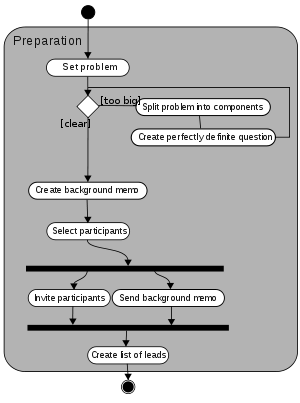Brainstorming
From Learning and training wiki
- Select a specific problem, namely define the problem about which the brainstorming session should focus on. It must be a clear problem and, if too big, it should be broken into smaller parts, each one related to a question. Before the brainstorming session, it may be also useful to send the participants an invitation, containing a description of the problem, so they can start thinking about it;
- Select suitable participants, ideally between six and twelve, both non-experts and experts. It is important that they have a positive attitude towards brainstorming and an open way of thinking. Each member of the group should participate, since observers can inhibit the creative process;
- Create a positive environment, where each participant should feel comfortable and free. If the members of the group feel judged, the generation of unusual ideas can be inhibited and, therefore, managers can be discouraged from attending the brainstorming session;
- Select a group moderator, who should be able to conduct the discussion and to enliven it, if the creativity decreases. A list of lead questions may helps the facilitator in this duty;
- Aim to generate a large quantity of ideas, according to the assumption that it increases the probability to produce a fit solution to the problem (quantity breeds quality);
- Avoid judgement and criticism, since the negative thinking can demotivate some members of the group to contribute their ideas and, moreover, unusual perspectives often help to the effective solution;
- Combine ideas by a process of association in order to improve them, according to the slogan 1+1=3.}}
| {{{1}}} |

